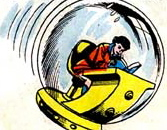 Hey, ho, Bubblenauts! Time for another trip down DC’s memory lane, as we drop out of the time stream this trip in April, 1982 — 35 years ago! — to witness the first appearance of New Teen Titans baddie, Brother Blood!
Hey, ho, Bubblenauts! Time for another trip down DC’s memory lane, as we drop out of the time stream this trip in April, 1982 — 35 years ago! — to witness the first appearance of New Teen Titans baddie, Brother Blood!
Of course, casual comics fans will know BB best as the junior Big Bad from Season 2 of The CW’s Green Arrow adaptation, Arrow.
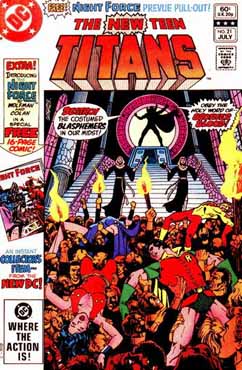 NEW TEEN TITANS #21
NEW TEEN TITANS #21
(on sale Thursday, April 15, 1982)
It’s hard today to imagine what a revelation The New Teen Titans comic was. After all, the old Teen Titans had never exactly set the world on fire. The team’s Silver Age run, though it lasted from 1965 to 1972, presumably languished at the bottom of DC’s sales charts, as it never climbed out of bi-monthly publication status. And it’s Bronze Age run, though one of my favorite titles at the time, only lasted 10 issues. We often think of the title today as one of many killed in the infamous DC Implosion, but the fact is it died in Nov. 1977, a good seven month before the collapse, meaning its sales were worse than all those below the infamous line drawn by some nameless Time Warner exec, who said in mid-1978, everything below here has to go.
So, there was certainly no expectation that the Titans would be any kind of success the third time out of the gate — or that there was any market at all for its existence. In fact, it’s been said that DC Publisher Jeanette Kahn at first reacted with abject horror when a Teen Titans revival was the first thing pitched to her by Len Wein and Marv Wolfman, after she had successfully lured them away from Marvel. She must have wondered for a moment if Wein & Wolfman were actually double agents secretly sent by Jim Shooter to sink the Distinguished Competition once and for all.
But yet another Teen Titans try made a certain amount of sense. The Uncanny X-Men was white hot at the time and hadn’t it come from the dead, after years of languishing in reprint mode? And hadn’t Wein been instrumental in orchestrating the revival of that franchise? And even if DC’s teens were mostly legacy heroes and not mutants, the Titans still stood as the the best answer to DC had Marvel’s powerhouse X-book, at least outside of the Legion of Super-Heroes.
So, with George Perez, who defected from Marvel at the same time, Wein (as editor) and Wolfman (as writer) followed the same basic formula as the X-Men revival, producing a team that was a blend of classic characters (Robin, Wonder Girl, Kid Flash, and Beast Boy, renamed as the less pubescent-sounding Changeling) and all-new creations (Cyborg, Raven, and Starfire). After a preview in DC Comics Presents #26, New Teen Titans #1 was an instant smash hit. Although Comichron.com does not have sales data going back that far for the Titans, there are plenty of claims to be found across the internet (which is always right, natch!) that NTT#1 sold five times what the typical DC title was managing at the time. If true, that’d put sales well to the north side of a half-million copies!
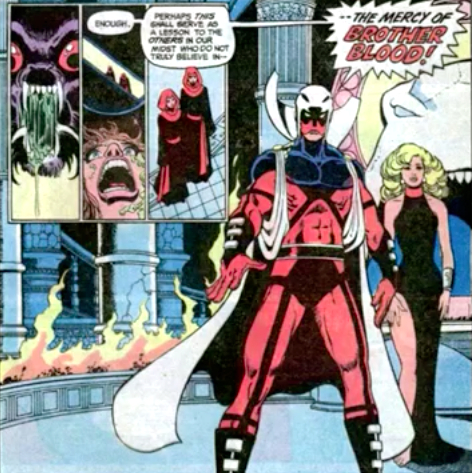 New Teen Titans #1 also holds a special place in my heart apart from it being one of my all-time favorite comic book titles. The debut issue hit newsstands on Aug. 15, 1980. I was 12 years old at the time, soon to turn 13, and had already amassed a comic book collection that must have numbered at least 500-600 issues. I had just returned from buying a fresh stack of six comic books one summer Saturday afternoon, with New Teen Titans #1 the choice score of the batch, and was eagerly devouring it at my grandparent’s house, having gone there, instead of home. I dunno why. My grandmother had died about six months earlier and I guess I just liked to hang out there sometimes. Anyway, I happened to look up from my new comic and out the window for some reason — some psychic impression that said, “Look up, right now!” — and, so, saw the first lick of flame curling out the kitchen window of the mobile home next door, where I lived with my mom and step-father. This being an early ’70s vintage trailer, it went up like a roman candle and was completely engulfed — a total loss — before the fire department ever got there. Just like that, my whole world was reduced to the clothes I had on my back, and six comic books, including that New Teen Titans #1.
New Teen Titans #1 also holds a special place in my heart apart from it being one of my all-time favorite comic book titles. The debut issue hit newsstands on Aug. 15, 1980. I was 12 years old at the time, soon to turn 13, and had already amassed a comic book collection that must have numbered at least 500-600 issues. I had just returned from buying a fresh stack of six comic books one summer Saturday afternoon, with New Teen Titans #1 the choice score of the batch, and was eagerly devouring it at my grandparent’s house, having gone there, instead of home. I dunno why. My grandmother had died about six months earlier and I guess I just liked to hang out there sometimes. Anyway, I happened to look up from my new comic and out the window for some reason — some psychic impression that said, “Look up, right now!” — and, so, saw the first lick of flame curling out the kitchen window of the mobile home next door, where I lived with my mom and step-father. This being an early ’70s vintage trailer, it went up like a roman candle and was completely engulfed — a total loss — before the fire department ever got there. Just like that, my whole world was reduced to the clothes I had on my back, and six comic books, including that New Teen Titans #1.
Today, I’m 49 and have 19,243 comics in my collection, all built around that #1 by Wolfman & Perez.
I missed the next couple of issues. You’ll understand, the greater concern was, “is the kid going back to school with any kind of wardrobe,” and, “does he have a bed to sleep on,” took some prominence over, “did he miss getting New Teen Titans #2 with the first appearance of Deathstroke?”
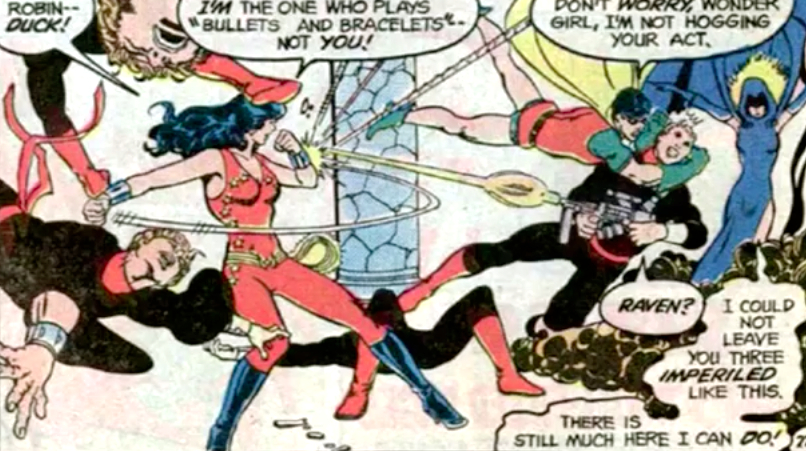 Once funds freed up and I started getting an allowance again, New Teen Titans #4 was the first book I bought. Then I scoured every newsstand in town in hopes of finding a #2 or 3 tucked away behind other unsold comics and magazines. No luck, though. It would be more than a decade before I filled those holes.
Once funds freed up and I started getting an allowance again, New Teen Titans #4 was the first book I bought. Then I scoured every newsstand in town in hopes of finding a #2 or 3 tucked away behind other unsold comics and magazines. No luck, though. It would be more than a decade before I filled those holes.
So, anyway, the New Titans probably would have been a favorite book for me. But circumstances being what they were, the title took on a kind of special significance in my eyes.
Which brings us to Issue #21. Wolfman & Perez, with Romeo Tanghal on inks, had already shown a talent for bringing quiet moments to peak emotional life. The “Day in the Life” episodes of Issue #8 come to mind. But this issue was particularly strong, with the frantic telephone conversation between Cyborg and an ex-girlfriend, Marcy Reynolds, as she is cornered and killed. Plus, the scene prior to that, as Marcy is tracked down and tension is established as we learn the lengths to which her pursuers will go, and the scene where Cyborg finds Marcy’s body, which we never see, but can well imagine thanks to the groundwork laid by the earlier confrontations, and by Cyborg’s intense, gut-wrenching reaction. As it turns out, Marcy was killed for trying to leave the cult of Brother Blood and the rest of the Titans decide to help Cyborg bring him to justice by infiltrating the church to gain evidence on its illegal ways. Think Scientology, with super-heroes.
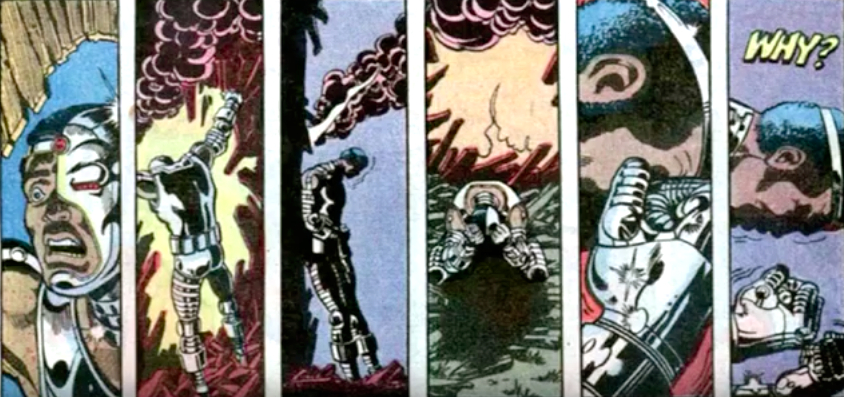
By modern standards, I guess Blood’s costume seems silly, but it sure creeped me out as a kid, as did Perez’ hyper-detailed depiction of his church. So, when Blood starts wiping out acolytes who wish to leave his graces, I found myself as horrified as the Titans, and, when Blood called them out, truly frightened for their safety. Keep in mind, I was all of 14 at the time, but I sure was engrossed in this issue the first time I read it.
The follow-up in Issue #22 features a bravura performance by Dick Grayson — in his pre-Nightwing days as Robin, the teen wonder — as he resists Blood’s interrogation and rescues his super-powered teammates from a giant spider using nothing but his wit, his skill, and his will to succeed. It’s a sequence that is for him, I think, everything Amazing Spider-Man #33 was for Peter Parker.
Blood’s goal was to spread his cult from his home nation of Zandia, gaining recognition from the U.S. for his country and his church. Toward that end, he gets some #FakeNews support from reporter Bethany Snow as the Titans appear to kill the supposedly immortal Blood.
In his next few appearances, we’d learn Blood was not immortal at all, but just the latest in a line of patricide that dated to 1202, when a priest used the Cloak of Christ to defeat his enemies and take control of Zandia, earning in the process a Papal curse that the father would always die at the hands of the son. It was an awesome set up, kind of an anti-Phantom, with Blood able to leverage a worldwide underground network. In that way, he was Kobra with a prayer book.
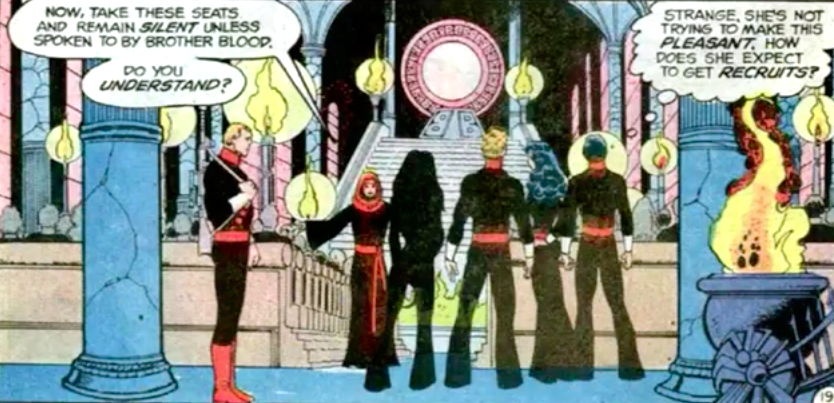
Brother Blood was a strong enough enemy, and an engaging enough character, that he was chosen to bridge the gap when DC launched a new direct-sales only volume and their first title transformed into a separate one meant to fill time until it would begin reprinting the stories in the main book, for readers like me without ready access to a local comic book store. DC needed a story strong enough to hold the regular comics fans to the newsstand title so that they would not abandon it completely in favor of the “real” title, and Brother Blood was chosen as the best bet to hold those eyeballs when New Teen Titans #40 rolled into Tales of the Teen Titans #41. After that, however, subsequent Blood battles seemed a pale imitation of his early forays into world dominion of hearts and minds. By the time Blood took center stage again in the new New Teen Titans volume (#28-31, released Nov. 11, 1986 to Feb. 19, 1987), Perez had long since left the title and Wolfman appeared to be running on steam.
Worst of all was Blood’s use on Arrow. Personally, I though the character was turned into a real cartoon version of his lamest adventures in print, and I actually felt sorry, if Wolfman and Perez were watching the show, that they had to suffer through this adaptation of their great creation.
There are two other things that make New Teen Titans #21 special. One is the opening scene in which Raven and Starfire prevent a terrorist bombing at a ballfield. After they save the day, the scene shifts to a mysterious satellite base where an unseen speaker declares the lady Titans more powerful than he had imagined. Although he then says this will be useful information for his “clients” — a statement that doesn’t quite jibe with his later raison d’être — this is, as it turns out, the first appearance of The Monitor . . . almost three full years before the start of the universe-changing Crisis on Infinite Earths. Clearly, I think, the Crisis was not yet envisioned when this scene was written, and Wolfman was probably just planting seeds here for he-knew-not-what yet.
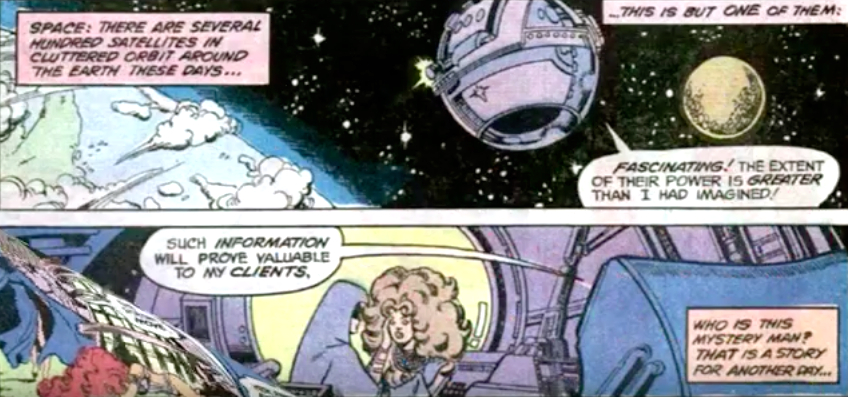
Also, this issue contains a free preview pull-out of Night Force, as the Titans return the advertising favor done for them in DC Comics Presents. I have never seen a copy of this issue with the Night Force pull-out actually pulled out, so I guess we can count ourselves lucky that few, if any, young comics fans succumbed to the invitation to make themselves two comic books for the price of one.
I was a big fan of the mysterious Baron Winters and his band of reluctant warriors on the Night Force, thanks in large part to seeing them here. As dedicated as I was to super-heroes at the time, there’s a good chance I might’ve given Night Force the miss if it had launched on its own accord without this advance publicity, prepared by Wolfman, with art perfect to the tone of the piece by Gene Colan and Bob Smith. I admit the second story arc in Night Force lost me a bit, as the title seemed to take on a strange, random feel after the first adventure concluded. Still, I stuck with the title for all 14 issues. The book was canceled based on poor sales at comics shops, where the early word came in thanks to the direct sales system. However, like many non-super-hero titles of the era, Night Force actually sold well to non-geek casual readers on newsstands, where I got it (although I was decidedly then, as now, well placed in the geek sub-species of homo sapiens). Still, Wolfman has said his horror series might well have survived longer had the DC bean counters waited for the full newsstand returns to come in before dropping the ax.
Nostalgia for the 1982 run of Night Force, which really boils down to nostalgia for New Teen Titans #21, has remained such that I bought into both subsequent series, launched in 1996 (lasting 12 issues) and 2012 (seven more, later described as a mini-series, though not launched as such as I recall), even though both were, with kindness to Wolfman, far inferior to the first story arc of the first series.
Anyway, this ish of NTT is a bit more valuable that the issues immediately before or after it, generally trading these days for $10 in Near Mint condition. That’s a 1,900 percent gain on the 50¢ cover price, if you happened to buy yours new off the stands like I did. Of course, mine’s not NM anymore. I’ve read it more than a few times, and also made the teenage mistake of loaning it out to a friend to read.
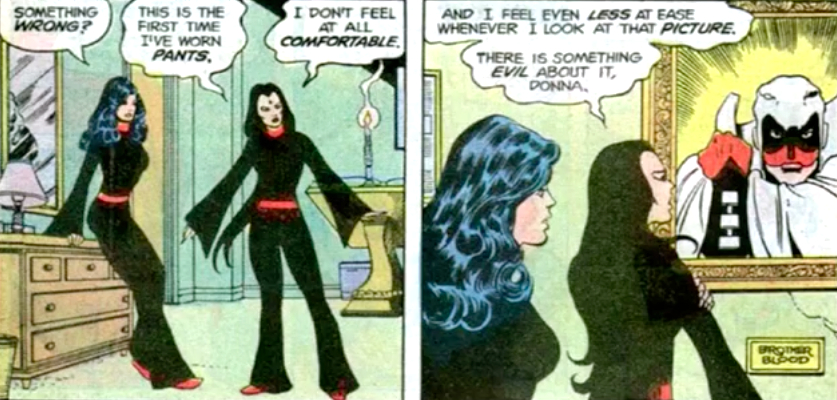
Also published by DC Comics 35 years ago this month — making them now eligible to run for President of the United States! — we find the following, a few of which you might think to have been bigger deals, historically, than the first appearance of Brother Blood. The price after each issue is the current going rate for a NM copy, at least according to ComicBookRealm.com.
On sale Thursday, April 8, 1982
 ARAK, SON OF THUNDER #11
ARAK, SON OF THUNDER #11
Arak encounters, “The Gods After Twilight,” in a story drawn by Ernie Colon and Alfredo Alcala, as written by Arak creator Roy Thomas. I remember really wanting to like this book as a kid. The adventures of a Viking-era native American pushed all the right escapist literature buttons for me at the time, but with centaurs and harpies and satyrs (oh, my!), as in this issue, I quickly lost interest in the title, finding in it little more than Discount Conan. Maybe not surprising, as Roy wrote that title for many a year before coming over to DC. —— $3.00
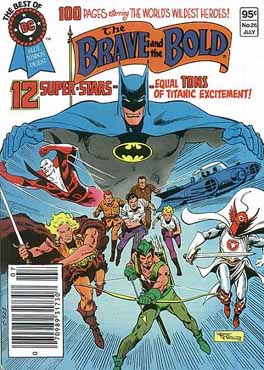 THE BEST OF DC #26
THE BEST OF DC #26
Ah, the era of DC’s brief but glorious foray into digest-sized comics. With the direct sales system in its infancy, and not yet a sure savior of the industry, DC was trying to regain traction at traditional newsstands, hoping to land sales with the same mini-packaging, friendly to grocery store checkout aisles, with which Archie Comics had so much success. For whatever reason, however, the digests were almost all reprint collections, with little new material. Because they sold so poorly, or maybe because they mostly sold to casual fans (or more correctly, to the moms of casual comics fans) who treated them as the disposable entertainment comics were always meant to be, these books are hard to find today. It’s been decades since I saw one on sale in a comic book store, and I don’t even see them pop up on eBay all that often. This one is a Brave and the Bold collection, featuring a Batman/Deadman team-up from B&B #86 (1969), along with pre-super-hero stories of Robin Hood (B&B #9, 1956), the Suicide Squad (B&B #38, 1961), Viking Prince (B&B #18, 1958), Silent Knight (B&B #21, 1958), and Cave Carson (B&B #31, 1960). For a lot of these stories, this was the only time they were ever reprinted. —— $15.00
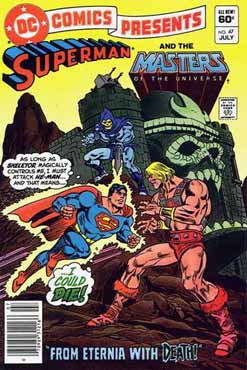 DC COMICS PRESENTS #47
DC COMICS PRESENTS #47
It’s the first appearance of He-Man and the Masters of the Universe in the DCU, pre-dating a special insert that would appear in several DC titles in August of this year. And that makes this the most expensive DC back issue from April 1982, trading these days at $90 in NM. “From Eternia — with Death” is written by Paul Kupperberg, with art by Curt Swan and Mike DeCarlo. The story features the first appearance of He-Man as Prince Adam, as this story came out before the cartoon series, and earlier mini comics packaged with action figures did not feature a secret identity. In a back-up tale, it’s the next-to-last entry in DCP’s “Whatever happend to . . . ?” series, this one detailing the fate of Sandy, the Golden Boy, kid sidekick to Sandman during comics’ Golden Age. Last seen eight years earlier as a mutated sand monster in Justice League of America #113 (out June 4, 1974), in a story designed to explain where he had been since the Golden Age, Sandy would finally regain human form in this tale written by Mike W. Barr and drawn by Jose Delbo and John Calnan. Of course, in the post-Crisis continuity, Sandy would join the Justice Society circa 1999 as a sand-powered silicon-based life form, by then calling himself just “Sand.” —— $90.00
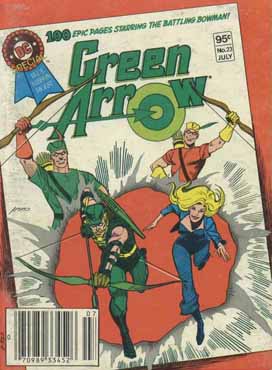 DC SPECIAL BLUE RIBBON DIGEST #23
DC SPECIAL BLUE RIBBON DIGEST #23
It’s an all-Green Arrow issues in the next-to-last issue of this series, featuring reprints of stories from World’s Finest Comics #98 (1958), #102 (1959), and #113 (1960), Adventure Comics #250, #252, and #253 (all from 1958), Brave and the Bold #85 (1969), DC Super-Stars #17 (1977), Green Lantern #87 (1971), and Action Comics #428 (1973), all built around a new framing sequence by Barr and Dan Spiegle. —— $22.00
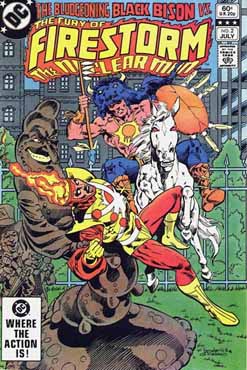 THE FURY OF FIRESTORM #2
THE FURY OF FIRESTORM #2
I was a huge, huge, HUGE fan of the original Firestorm series from 1978 and I so wanted to fall in love with this second solo series. But for whatever reason, this title just never caught fire (storm) with me and I think I wandered off it by Issue #10, or so, only checking back in occasionally. “Rage” continues from #1, with the story by Firestorm co-creator Gerry Conway and art by the team of Pat Broderick and Rodin Rodriguez. And even if this series wasn’t my personal cuppa, it still lasted 100 issues, all the way to June 12, 1990 — although it lost its “Fury” along the way, becoming Firestorm, the Nuclear Man on the cover at #51, and officially in the incidia at #65, and then finally just Firestorm with #93. —— $4.00
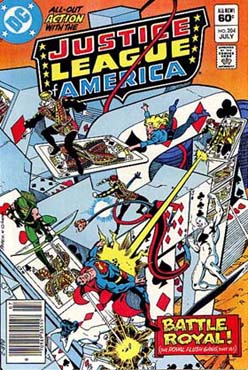 JUSTICE LEAGUE OF AMERICA #204
JUSTICE LEAGUE OF AMERICA #204
These days I have a lot of respect for Don Heck, but at the time, following on the heels of a JLA run by Perez, then at the top of his form, and with Heck entering the nadir of his career, I was sorely disappointed in this book. “The Cut of the Cards” is the middle chapter of a three-part tale by Conway, and inked by Thanghal, pitting the JLA against The Royal Flush Gang. This second iteration of the team was based on the suit of spades, the original team from JLA #43 (Jan. 25, 1966) having been clubs. —— $5.00
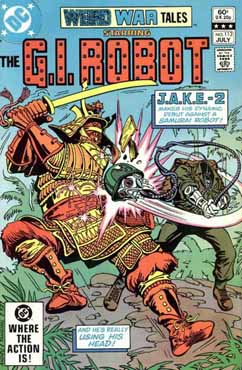 WEIRD WAR TALES #113
WEIRD WAR TALES #113
Although his name appeared alongside The Creature Commandos on a few outings, this is the first of just three Weird War issues on which G.I. Robot gets the prime logo real estate (the others being #s 120 and 122). G.I. Robot was exactly what he sounds like: An automated soldier circa World War II. He made his debut appearance in Star Spangled War Stories #101 (Dec. 19, 1961). That model was nicknamed “Joe” and this issue features the first appearance of the fourth iteration, known as J.A.K.E. 2 (for, Jungle Automatic Killer, Experimental Number 2). He followed robots known as “Mac” (first appearing in Star-Spangled War Stories #125, out Dec. 16, 1965) and J.A.K.E. 1 (Weird War Tales #101, published April 9, 1981). “The Robot and the Samurai” is by Robert Kanigher and Fred Carrillo. Two back-up tales in this issue are written by Robin Snyder and Martin Pasko, respectively, with early artwork by Paris Cullins and Mark Silvestri, as inked by Adrian Gonzales and Larry Mahlstedt. —— $8.00
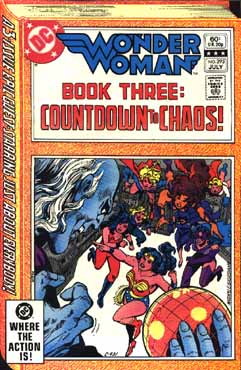 WONDER WOMAN #293
WONDER WOMAN #293
If Don Heck seemed an odd artist-choice for the JLA, the moody, evocative stylings of Colan was a similar head-scratcher when it came to Wonder Woman, and yet he had a longish run on the title, from #288 (where she got the WW costume icon that replaced the untrademarkable eagle motif), until #305 — a run actually bookended by Heck, FWIW. This issue, written by Paul Levitz and inked by Frank McLaughlin, is the third part of an all-jugs tale that co-starred Huntress, Madame Xanadu, Phantom Lady, Power Girl, Supergirl, Zatanna, Wonder Girl, Starfire, and Raven. —— $7.00
On sale Thursday, April 15, 1982
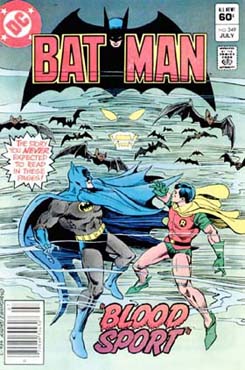 BATMAN #349
BATMAN #349
See, now Colan made a LOT more sense on Batman than on Wonder Woman, and this period of the caped crusader’s career remains a particular favorite of mine to this day. “Blood Sport” is by Conway, Colan, and Alcala, and guest starts a couple of guys you don’t hear a lot from these days — The Human Target and P.I. Jason Bard. Oh, and Batgirl, who, if I recall correctly, was canoodling with Bard around this time. The back-up story features Catwoman, by writer Bruce Jones and artists Trevor Von Eeden and Mahlstedt. DC made a big deal out of these back-up features when the comics went to 50¢ in June 1980, but as the cover price advanced to 60¢ they slowly faded away. Catwoman’s series ran in #332, 333, 345, 346, 348-351, and she popped in the main feature quite a bit during this period as well. And, I’ll be honest with you, I kind of miss this version of her costume. —— $15.00
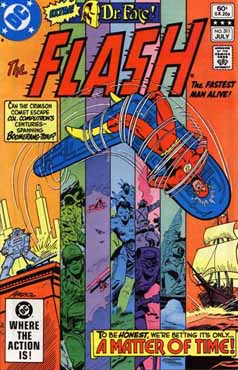 THE FLASH #311
THE FLASH #311
I had been a big Flash fanatic during the mid-to-late ’70s, but I began to fade away from the title after #300. The reason? I just wasn’t into Carmine Infantino‘s artwork. In the early 1980s there were a lot of great, great artists who where closing out their careers, including Infantino and Heck (mentioned above), along with Jack Kirby, Curt Swan, Steve Ditko, etc. — all fantastic artists I would later learn to really love and appreciate as I caught up with their earlier work. And, in truth, I like their ’80s efforts a lot more now than I did then. But as a 14-year-old at this time, and their current output being pretty much all I knew, I found their pages to be terribly static and staid, completely lacking in dynamisim. In some instances, as with Swan, I think they got saddled with inferior inkers to the ones they had known the heights of their careers in the 1960s. But in most cases, I think it was just age. After a while, artists build up a sort of hand memory and they go on auto-pilot, drawing the same characters the same way they have for decades, and the lack of enthusiasm and discovery in their work shows through. Of course, I wasn’t the only one dropping out of The Flash at the time, as Barry Allen had fewer than 40 issues worth of run left in him before he’d take a big ol’ dirt nap for a couple of decades. The back-up story features Dr. Fate by Steve Gerber and Pasko, as drawn by Keith Giffin and Mahlstedt — the same team that was soon to set the Legion on fire. Fate’s back-up series in Flash was short-lived, running from #308-313. —— $6.00
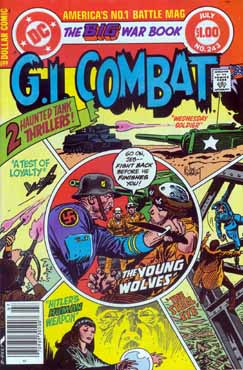 G.I. COMBAT #243
G.I. COMBAT #243
The dollar-sized giant format seemed to work well for this title, lasting longer here, as I recall, than anywhere else. The title went big book with #201 (Jan. 13, 1977) and stayed that way even through a price increase to $1.25 at #260 (Sept. 15, 1983) until #281 (Dec. 12, 1985), before converting to regular size, at the then-entry fee of 75¢ for its final seven issues. Thisish features two Haunted Tank stories by Kanigher and Sam Glanzman, with Dick Ayers penciling one, along with O.S.S. Spies at War by Kanigher and Ernie Cruz, and two war genre tales — one by Paul S. Newman (not to be confused with the actor) and Frank Redondo, and the other by George Kashdan and Vic Catan Jr. As with most of the war/mystery/horror books of this period, relative scarcity as back issues, especially in high grade compared to concurrent super-hero comics, means this commands a premium price on the modern market. —— $16.00
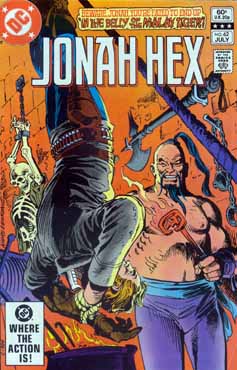 JONAH HEX #62
JONAH HEX #62
It’s hard to imagine today, but there was a time super-heroes did not dominate the comics market, and until the mid-’80s, or so, when the direct sales system really took hold and comics distribution shifted forever from newsstands to comic book stops, characters like Jonah Hex, The Warlord, Sgt. Rock, and The Unknown Soldier, more than held their own. I remember at the time wishing these heroes could somehow get together and form their own team, and spent a lot of fan-ficting time around this period trying to come up with plausible time-travel scenarios to make that happen. Anyway, Hex was in fine mid-series form here in, “The Belly of the Malay Tiger,” by Michael Fleisher, Ayers and Tony DeZuniga. —— $9.00
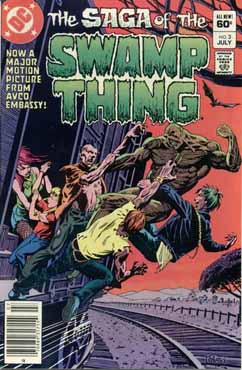 THE SAGA OF THE SWAMP THING #3
THE SAGA OF THE SWAMP THING #3
I remember when this series came out thinking, “Why??” I mean, there had not been any clamoring for a return of the muck monster in any of the fan press I had access to at the time, and so, when DC announced this title, it came as a complete surprise. Maybe that attitude prejudiced me to the book, but I only tried the first few issues, The early stories by Pasko and Tom Yeates were like, yeah, okay, whatever, and I bailed. But, as noted above, DC could confidently publish things in this era that did not feature super-heroes. Still, for me, the real draw of this series was the Phantom Stranger back-up tales by Barr (which was drawn this outing by Spiegle. The Stranger would last until Issue #13, before teaming up with Swampy in the main tale for #14-15, by which time I had already bailed. And, of course, a then relatively unknown Alan Moore would come on board with #20 and change the world, something I would completely miss out on at the time. —— $4.00
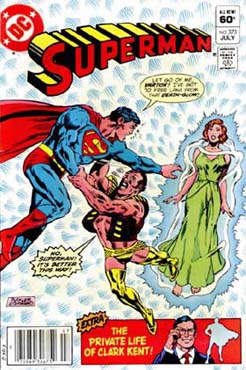 SUPERMAN #373
SUPERMAN #373
This was a real low period for The Man of Steel, when the art was kind of bland and in seemed every story about him that could possibly be written had already been done. Not even the patent absurdity of Vartox could lure me back. “Lana Lang’s Farewell to Earth” was the first chapter of a three-part tale by Cary Bates, Swan and Dave Hunt, the latter of whom just passed away March 5 at age 75. In the “Private Like of Clark Kent” back-up feature, by Bob Rozakis and John Calnan, Clark helps Supergirl keep her job as an actress on a soap opera. Yup, that’s what Kara did at this time when not fighting crime. Like Green Lantern and Captain America, she had a hard time holding a job as writers where forever giving her new careers in a vain attempt to make her civilian identity semi-interesting. —— $7.00
On sale Thursday, April 22, 1982
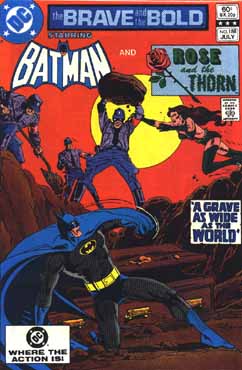 THE BRAVE AND THE BOLD #188
THE BRAVE AND THE BOLD #188
Batman teams-up with Rose and the Thorn, who may well be the Queen of DC’s D-List characters. First appearing in Superman’s Girlfriend, Lois Lane #105 (Aug. 13, 1970), the character was a split personality, with Thorn being the crime-fighting vigilante persona of meek Rhoslyn “Rose” Forrest, initially coming out only when Rose when to sleeep, which must have left the poor dear utterly exhausted. Created by Kanigher and Andru, she started out with a back-up feature in Lois Lane, then bounced around for years, looking to make an impression with readers. She did eventually get her own six-issue mini series in 2004, which was written by Gail Simone, because, like Thorn, she has a hoo-hoo, so she obvs gets to write all the female characters. “A Grave as Wide as the World” is by Kanigher and Jim Aparo. This issue also has a Nemesis back-up story by Cary Burkett and Spiegle. Nemesis was a master of disguise, much like the Human Target, but was a government operative rather tan a body guard. His B&B series ran from #166-192, with full-length Batman team ups in #170 and 193. It was a pretty good series that, IMHO, deserves to be collected by DC into a TPB. —— $6.00
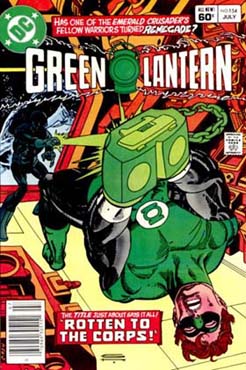 GREEN LANTERN #154
GREEN LANTERN #154
I was a big fan of this title in its Green Lantern/Green Arrow days, but slowly lost interest once GL went solo. Sometime in the mid-1990s I bought the entire run, from where I left off to the end of the series, from a back issue dealer named “Friendly Frank,” who used to advertise in the much-missed Comics Buyers’ Guide, but to this day I’ve never sat down to read them through. “Rotten to the Corps” in this issue is by Barr and Joe Staton, with Robert R. Smith, while the Corps gets a story of its own in the back-up by Kupperberg and Cullins, with Rodriguez. —— $6.00
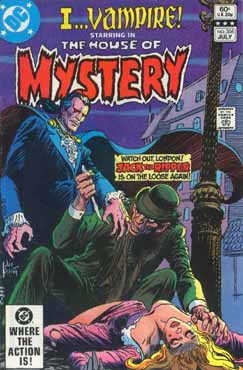 THE HOUSE OF MYSTERY #306
THE HOUSE OF MYSTERY #306
HoM only rarely tried to run a continuing feature, with the Martian Mainhunter and Dial H for Hero being the notable examples from the 1960s. Toward the end of the title’s run, it was the series I . . . Vampire! that won the top spot, with the series even displacing the HoM logo for many later issues. Created by J.M. DeMatteis, the series might be seen as DC’s answer to Marvel’s Tomb of Dracula. Of course, Night Force also was an answer to Drac, and by the fella who wrote that book, too. Be that as it may, Vampire ollows 16th century nobleman Lord Andrew Bennett in the modern day as he tries to defeat the cult of the Blood Red Moon, founded by a former lover Bennett had made a vampire like himself, who kinda went a little goofy as a result and took to calling herself the Queen of Blood. With Bennett refusing to drink anything but bottled blood, the series has been said to carry a strong subtext of alcoholism. The series ran in House of Mystery #290, 291, 293, 295, 297, 299, 302 and 304-319 with a Batman team up in The Brave and the Bold #195. The entire series was collected in a 2012 TPB. But before that, the character got a meterosexual reboot in DC’s New 52 reboot, in a title that lasted 19 issues — 20 if we count the #0. Anyway, the story in this issue, “Rip in Time,” is by Bruce Jones and Tom Sutton, while rounding out the issues are genre horror-lite tales, “A Rift in the Veil,” by Joey Cavalleri and Ernesto Patricio, and “Royal Blood,” by Wyatt Gwyon and Greg Curry, with DeZuniga on inks. Never heard of any of those latter names? Yeah, HoM was kind of a try-out title in this period of its life, and not everyone whose name appeared in the credit box went on to long and notable comic book careers. —— $18.00
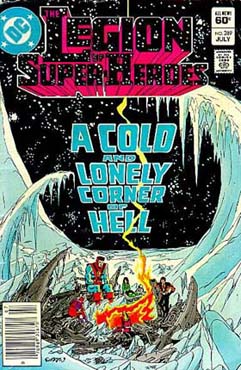 THE LEGION OF SUPER-HEROES #289
THE LEGION OF SUPER-HEROES #289
Now this is the comic book I almost lead this Time Bubble column with, instead of the New Teen Titans issue. It is, to my mind, an all-time classic. But then, I am a huge Legion fan, so my feelings on the subject might not be in line with the balance of comics fandom. Plus, I sort of made a decision at the outset of this column to feature big events and character debuts, rather than comics that just had really great stories. But this one, entitled, “A Cold and Lonely Corner of Hell,” is totes faboo. In it Paul Levitz, Giffin, and Bruce Patterson, depict a group of Legionnaires stranded on an asteroid in a tale that, while light on action, is super-strong on characterization. The story leads into The Great Darkness Saga, with Darkseid appearing here in shadows, his identity as-yet unrevealed. As such, this issue was not included in the 1989 TPB collection of the saga, although it did make the 2010 hardcover deluxe edition. Besides leading into what is widely-regarded as the greatest LSH epic of all time, this story also launches several plot lines that will resolve following the Great Darkness, including Chameleon Boy’s daddy issues and the fact that Shrinking Violet is not here who we suppose her to be. There’s also the Timber Wolf/Saturn Girl dalliance that will lead to his break-up with Light Lass and her eventual relationship with the real Violet. Everything in this issue sets up major character traits that persist to this day and would be hard to ignore for the writer of DCs’ eventual Legion reboot. Unfortunately, the back-up tale by Levitz, Infantino, and Mahlstedt is eminently forgettable. It features Brainiac 5 and Element Lad picking up Matter-Eater Lad from the sanitarium (where he’s drooled away since eating the Miracle Machine way back in Superboy and the Legion of Super-Heroes #251 (Feb. 22, 1979) and losing his mind. They intend to take him back to Legion HQ to finally effect a cure, but run into a little trouble along the way, only winning the out thanks to a dues ex flower and a previously unmentioned Trommitte hyper-alergy to pollinating buds. —— $6.00
 SGT. ROCK #366
SGT. ROCK #366
An incredible five stories round out this 32-pager, although most are only 2-4 pages in length. Still, the war genre lends itself well to short vignettes and Rock was always a crowd-pleaser. Thanks to him, I feel like I know WAY more about World War II than I ever will about Korea, Vietnam, or any of our adventures in Afghanistan and Iraq. The lead story is by Kanigher, although the authorship of the other tales, but for the two-pager by Bill Kelley, is now lost to time. The art chores are handled by Redonto, Ron Randall, Tom Mandrake, and Kim DeMulder, with one art credit still unknown, according to the Grand Comics Database. —— $9.00
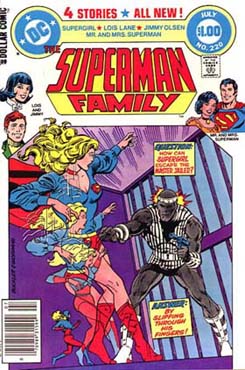 SUPERMAN FAMILY #220
SUPERMAN FAMILY #220
It’s the antepenultimate issue for this Super-jam book, which launched at #164 (Jan. 24, 1974) with the merger of DC’s Supergirl, Jimmy Olsen, and Lois Lane titles into a single series. Here the title is just two issues away from cancellation at #222. It’s the unusual lineup with Supergirl teaming with The Atom to fight Prison Master in a “Battle Beneath the Brooklyn Bridge,” by Kupperberg, Win Mortimer, and Vince Colletta; Jimmy finding “Old Friends . . . New Betrayal,” against Brain Storm, by Kupperberg, Jose Delbo and Joe Giella; Lois learning “Dead Men Do Tell Tales,” by Tamsyn O’Flynn, Bob Oksner, and Colletta; and Mr. & Mrs. Superman (the married, albeit childless, Superman and Lois of Earth-2) asking “Where on Earth Are You From?” with the help of E. Nelson Bridwell, Kurt Schaffenberger, and Dan Adkins. The latter tales were always the highlight of any SF issue for me and this one features what I believe is the only appearance of an Earth-2 “Super-Girl,” called Linda Lee by Lois,” (real name Liandly) although she is from the planet Rolez, not Krypton, and has a different power set, including telepathy. —— $8.00
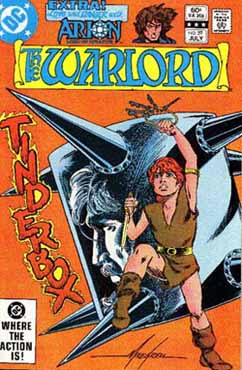 THE WARLORD #59
THE WARLORD #59
Thief master Darvin realizes the young boy known as Tinder is actually the Warlord’s long-lost son, Joshua Morgan, in “Tinderbox,” by Mike Grell, with inks by Mike DeCarlo. Although, in truth, the last two years of Grell’s writing on this series were only plotted by him. They stories actually ghost-scripted by his then-wife, Sharon Wright Grell. This issue also marks the end-of-an-era as the last regular issue of the series penciled by Grell. Meanwhile, the back-up tale features Arion, by Kupperberg and Jan Duursema, and the Lord of Atlantis, will graduate from the six-part tale that began in Issue #55 into his own 35-issue series, launched on Aug. 26, 1982. —— $3.00
On sale Thursday, April 29, 1982
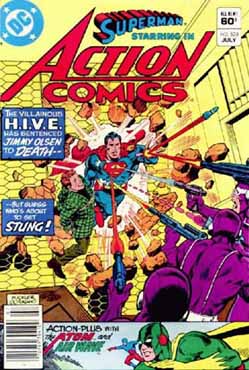 ACTION COMICS #533
ACTION COMICS #533
“Trackdown” is the conclusion of a two-part tale pitting Superman against the villainous forces of H.I.V.E., by Wolfman, Swan and Frank Chiaramonte. During this era, Action featured a rotating cast if A-characters in the back-up slot, including Aquaman, The Atom, and Air Wave. The latter always cracked me up. Made the nephew of Green Lantern simply because the Golden Age Air Wave was named Larry Jordan, this version, Jordan’s son, and also named Hal Jordan, made his debut in Green Lantern #100 (Oct. 25, 1977). The shtick of papa Jordan was getting to and from crime scenes by literally roller skating across telephone wires. Hal, meanwhile, had the Dazzler-like editorial misfortune of coming along able to actually ride radio waves just as personal computers were coming into existence. In this issue he and Atom team up in in a tale by Rozakis, Alex Saviuk, and Chiaramonte. —— $5.00
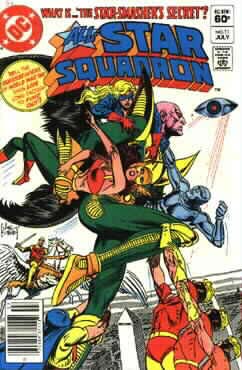 ALL-STAR SQUADRON #11
ALL-STAR SQUADRON #11
One of my favorite series back in the day, and still one of my favs of all-time, at least until Crisis on Infinite Earths began to screw with its continuity, ASS (er, wait . . . not a good acronym!) was a breath of fresh air for me as a kid. Although using Golden Age heroes and set during World War II, the series starred characters that were either all new, or else had not appeared elsewhere in quite some time. That gave me a sense of being able to get in on the ground floor of the narrative, whereas other DC series sometimes felt unapproachable. But more importantly, a lot of DC Comics where still very much episodic at the time. Don’t get me wrong, I prefer comics stories that don’t drag on forever, but there was a feeling one could skip and issue, or even a few, of most series, and still pick right back up wherever you left off. But A-SS (nope, still no good), had a lot of ongoing continuity. Yes the story arcs were short, but there was an overarching narrative in which one felt the characters could change and grow, and that kept me coming back for more, issue after issue, whereas with many other DC Comics of this time, I might skip and issue here or there if a particular issue didn’t click as I thumbed through it at the newsstand, leading something else to call out for my two buts. Plus, Jerry Ordway! So, every issue of All-SS (nope, also no good) was a must have. Thisish, part of a Hawk-centric arc that had the team battling alien Akhet — yes, an alien. A bit of a departure, but it worked — is by Roy Thomas, Adrian Gonzales, and Ordway. —— $4.00
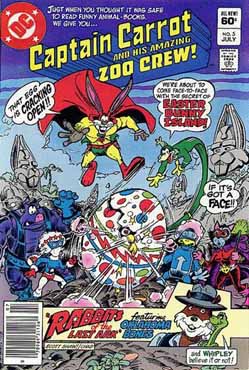 CAPTAIN CARROT AND HIS AMAZING ZOO CREW! #5
CAPTAIN CARROT AND HIS AMAZING ZOO CREW! #5
Although it lasted a mere 20 issues, this title is still fondly remembered by fans and even got one of the last slots, in 2014, in the great Showcase Presents line of big B&W “phone book” reprints. “The Secret of Easter Bunny Island” is by Thomas, Scott Shaw!, and Chad Grothkopf, and features an Indiana Jones parody in “Rabbits of the Lost Ark,” which hit stands just 10 months after release of the first Indy movie. Personally, I had mixed feelings about this title’s early demise. It was a concept I truly wanted to like, but in execution it wasn’t whatever it was I thought I wanted out of something like this, and after the first few issues, it never seemed to make the final cut in my trips to the newsstand, when I hit my allowance limit and had to make hard choices. —— $4.00
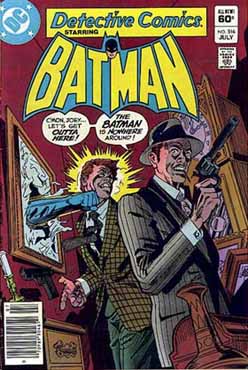 DETECTIVE COMICS #516
DETECTIVE COMICS #516
Co-written by Conway and Kupperberg, this issue features art by one of my all-time favs, Don Newton, with inks by Chiaramonte. Between Colan on Batman and Newton here, this was truly a Golden Age for Batman so far as I was concerned, and a period of publishing greatness (in my ever so humble) rarely rivaled since in the annals of the Darknight Detective. Of course, it might help that creepo supreme Huge Strange was all over this Bat-title at the time, and Vicki Vale seemed to mesh well with the boy-centric cast. This issue also has a Batgirl back-up by Burkett, Delbo and Giella. —— $6.00
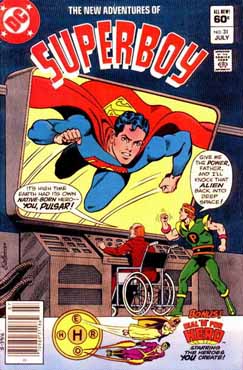 THE NEW ADVENTURES OF SUPERBOY #31
THE NEW ADVENTURES OF SUPERBOY #31
Launched at the same time as the Legion’s first (non-reprint) solo title, these New Adventures always seemed terribly dated to me. That may be because of the Schaffenberger art, although I enjoyed him immensely elsewhere. These days I look back on this series fondly, and have been actively trying to complete the run. But I admit that back in the day I snubbed my nose as this title as an “Archie” version of Superman, meant for little kids, of which I most decidedly was not one, said I, at 14. Most issues of this series were written by Cary Bates, but this one, with the familiar trope of the super-powered boy rival (this one named Pulsar) is a fill-in by Blue Devil creators Gary Cohn and Dan Mishkin. Even today, DC could make a nice villain team out of all the anti-Superboy’s like Pulsar from across the decades. The Dial H or Hero back up is by Bridwell and Rozakis, with art by Howard Bender and Adkins. —— $3.00
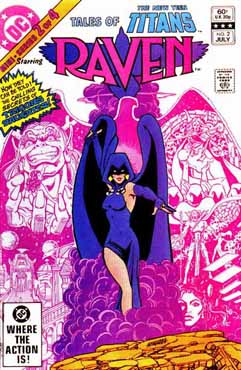 TALES OF THE NEW TEEN TITANS #2
TALES OF THE NEW TEEN TITANS #2
As a measure of just how popular the New Teen Titans were at this time, DC granted the team, just 20 issues into its run, one of the first ever limited series, and just the second to run not three, but the new standard of four. The publishing format began with The World of Krypton (April 12, 1979) as a way to burn off material left stranded in DC’s inventory draw by the death of Showcase in the DC Implosion. Then came The Untold Legend of The Batman (April 24, 1980), Secrets of the Legion of Super-Heroes (Oct. 9, 1980), Tales of the Green Lantern Corps (Feb. 5, 1981), The Krypton Chronicles (June 4, 1981), The Phantom Zone (Oct. 22, 1981), and then this series on March 25, 1982. Each issue gave the full and complete back story of the new, New Titans, by Wolfman and Perez, with inks by different artists. Marcos did this issue. The spotlight was on Cyborg (#1), Raven (#2), Changeling (#3) and Starfire (#4). Sadly, much of what was depicted in these origin issues has since been retconned away, or else otherwise invalidated in the New 52/Rebirth reboots, as well as by various hypertime quirks along the way. Still, for me, these four issues stand as the definitive origins of these characters. Everything since is just an Elseworlds. —— $8.00
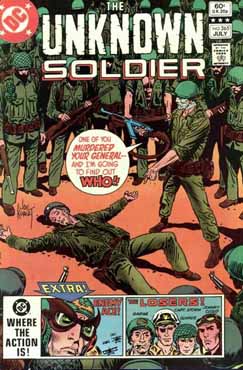 THE UNKNOWN SOLDIER #265
THE UNKNOWN SOLDIER #265
Just three issues away from cancellation after first appearing in Star-Spangled War Stories #151 (April 21, 1970) and taking over the title in his own name with #205 (Jan. 18, 1977), the war will end for the Unknown Solder at #268 (July 22, 1982). Thisish is by Haney, Ayers and Gerry Talaoc, with backups featuring The Losers, by Kanigher and George Evans, and Enemy Ace, by Kanigher and John Severin. I never bought this title as a kid. In truth I don’t recall ever seeing Star-Spangled on the stands at Joe’s Smoke Shop in Waterville, Maine, or at the Pik Qwik, after we moved to Skowhegan. I do recall seeing it as I got older and switched my comics buying to the Mr. Paperback store, which was further from my home, but had a much wider selection of comic books than the corner store. But by that time I was too deeply into super-heroes to bother with much of anything else. I did later get a near complete run from Friendly Frank though. —— $10.00
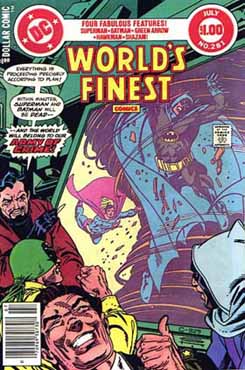 WORLD’S FINEST COMICS #281
WORLD’S FINEST COMICS #281
The giant-sized dollar format that began in Issue #244 (Jan. 13, 1977) will go away after the next issue. There will be an Atom back-up in #283, and Green Arrow tales in #283-284, but after that its strictly Superman/Batman through the end of this title’s life at #323 (Oct. 24, 1985). So, this is a last chance for a while to enjoy adventures of some of the heroes depicted herein. The Superman/Batman team (Supes still got top billing at this point in time) pits the World’s Finest team against one of the least fine villains ever, Major Disaster, in tale by Burkett, Irv Novick, and Chiaramonte. The Green Arrow story is by Cavalieri, Von Eeden and Mahlstedt. Next comes Hawkman, by Rozakis, Saviuk, and Chiaramonte. And lastly, SHAZAM, still called Captain Marvel, by Bridwell, Newton, and Calnan. After the WFC shrinkage, the Big Red Cheese would move over to the new digest-size version of Adventure Comics, where his new adventures stood out in a title that was otherwise all reprints. Hawkman, meanwhile, would have to content himself with bopping around the DCU, primarily as a Justice League member, until the start of his Shadow War in 1985. —— $10.00
And there you have it, kids, another Time Bubble excursion complete. Next week, we’ll travel back to April 1962 for, among other things, the very first issue of The Atom!
Until then, remember — “Hey, Kids! COMICS!”
